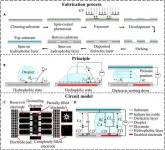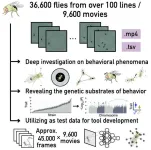(Press-News.org)
LUND UNIVERSITY/IMPERIAL COLLEGE LONDON PRESS RELEASE
[Peer-reviewed /Simulation/Modelling / People]
UNDER EMBARGO UNTIL:
Monday 14th April 2025
10:00 am US Eastern Time / 3:00 pm UK Time
Combination of drugs could prevent thousands of heart attacks
Patients who receive an add-on medication soon after a heart attack have a significantly better prognosis than those who receive it later, or not all.
This is according to a new study from researchers at Lund University in Sweden and Imperial College London. The findings suggest that treating patients earlier with a combination of statins and the cholesterol-lowering drug ezetimibe could prevent thousands of new heart attacks over a decade.
Cardiovascular disease is by far the most common cause of death worldwide, with heart attack (‘myocardial infarction’) being the most common acute event. For those who survive a heart attack, the risk of a new heart attack is greatest in the first year after the initial event because the blood vessels are more sensitive, making it easier for blood clots to develop.
Reducing LDL or “bad” cholesterol in the blood can stabilise changes in the vessels, decreasing the risk for new events. The current treatment guidelines for patients are high-potency statins immediately after a heart attack, to lower their cholesterol levels. However, the majority of patients do not reach recommended cholesterol levels using only statins, and so need an add-on treatment, such as ezetimibe.
“Today’s guidelines recommend stepwise addition of lipid-lowering treatment. But it’s often the case that this escalation takes too long, it’s ineffective and patients are lost to follow-up,” says Margrét Leósdóttir, Associate Professor at Lund University and senior cardiology consultant at Skåne University Hospital in Malmö, Sweden. “By giving patients a combination treatment earlier, we could help to prevent many more heart attacks.”
Co-investigator Professor Kausik Ray, from Imperial College London’s School of Public Health, said: “This study shows that we could save lives and reduce further heart attacks by giving patients a combination of two low-cost drugs. But at the moment patients across the world aren’t receiving these drugs together. That’s causing unnecessary and avoidable heart attacks and deaths – and also places unnecessary costs on healthcare systems. Our study shows the way forward; care pathways must now change for patients after this type of heart event.”
In the latest study, the international team examined outcomes for heart attack patients if they received a combination of statins with the add-on therapy ezetimibe (within 12 weeks after a heart attack), statins with ezetimibe added later (between 13 weeks and 16 months), or just statins with no ezetimibe at all.
Based on Swedish registry data from 36,000 patients who had a heart attack between 2015 and 2022, the researchers used advanced statistical models to emulate a clinical trial. The results show that patients who received a combination treatment of statins and ezetimibe within 12 weeks of a heart attack and were able to lower cholesterol to the target level early, had a better prognosis and less risk of new cardiovascular events and death than those who received the add-on treatment later, or not at all.
From the analysis, the researchers believe many new heart attacks, strokes and deaths could be prevented every year internationally if the treatment strategy were to be changed. Under a scenario in which 100% of patients would receive ezetimibe early, they estimate 133 heart attacks could be avoided in a population of 10,000 patients in 3 years.
The researchers suggest that in the UK, which records an estimated 100,000 hospital admissions from heart attacks a year,[1] this would equate to an estimated 5,000 heart attacks being prevented over a ten year period.[2]
Dr Leósdóttir said: “Combination therapy is not applied up-front for two main reasons. General recommendations are not included in today’s guidelines and a precautionary principle is applied to avoid side effects and overmedication. However, there are positive effects from applying both medicines as soon after the infarction as possible. Not doing this entails an increased risk. In addition, the drug we have examined in the study causes few side effects and is readily available and inexpensive in many countries.”
Margrét Leósdóttir hopes that the research results will in time provide support for changes in the recommendations. A treatment algorithm has already been introduced at her hospital in Sweden to help doctors to prescribe appropriate lipid-lowering treatment for patients who have had a myocardial infarction. It has been noted that patients achieve their treatment goals earlier and two months after the infarction twice as many patients have reduced their bad cholesterol to the target level, compared with previously.
“Several other hospitals in Sweden have also adopted the algorithm and there are similar examples from other countries that have produced as good results. My hope is that even more will review their procedures, so that more patients will get the right treatment in time, and we can thereby prevent unnecessary suffering and save lives.”
Professor Ray added: “Our findings suggest that a simple change in treatment guidelines could have a huge impact on patients and reduce the demand on the NHS. Ezetimibe is already widely available and prescribed for relatively low cost. This add on therapy could be rolled out for around £350 a year per patient, which is a huge cost saving compared to the lasting impacts of treating heart attacks and the impact they have on patients’ lives.”
‘Early Ezetimibe Initiation After Myocardial Infarction Protects Against Later Cardiovascular Outcomes in the SWEDEHEART Registry’ is published in the Journal of the American College of Cardiology (JACC).
DOI: 10.1016/j.jacc.2025.02.007
For more information, please contact:
Dr Margrét Leósdóttir,
Associate Professor at Lund University and senior cardiology consultant at Skåne University Hospital in Malmö, Sweden. Margret.leosdottir@med.lu.se
Tel. +46 732561536
Professor Kausik Ray,
Chair in Public Health, School of Public Health,
Imperial College London;
k.ray@imperial.ac.uk; Tel: +44 7960181754
Imperial College London press office: medicine.media@imperial.ac.uk
Notes to editors
This press release uses a labelling system developed by the Academy of Medical Sciences to improve the communication of evidence. For more information, please see: http://www.sciencemediacentre.org/wp-content/uploads/2018/01/AMS-press-release-labelling-system-GUIDANCE.pdf
[1] British Heart Foundation UK Factsheet January 2025 (Pg 8). ‘In the UK around 100,000 hospital admissions each year are due to heart attacks’ https://www.bhf.org.uk/-/media/files/for-professionals/research/heart-statistics/bhf-cvd-statistics-uk-factsheet.pdf
[2]
An estimated 5000 heart attacks could be prevented over a ten year period.[2]
This is based on 100% of a population of 100,000 patients receiving ezetimibe add-on early, preventing 1331 Major Adverse Cardiovascular Events (MACE) over three years. This translates to an estimated 4,437 MACE avoided over a ten-year period.
About Imperial College London
We are Imperial – a world-leading university for science, technology, engineering, medicine and business (STEMB), where scientific imagination leads to world-changing impact.
As a global top ten university in London, we use science to try to understand more of the universe and improve the lives of more people in it. Across our nine campuses and throughout our Imperial Global network, our 22,000 students, 8,000 staff, and partners work together on scientific discovery, innovation and entrepreneurship. Their work navigates some of the world’s toughest challenges in global health, climate change, AI, business leadership and more.
Founded in 1907, Imperial’s future builds on a distinguished past, having pioneered penicillin, holography and fibre optics. Today, Imperial combines exceptional teaching, world-class facilities and a habit of interdisciplinary practice to unlock scientific imagination.
https://www.imperial.ac.uk/
END
Combination of drugs could prevent thousands of heart attacks
2025-04-14
ELSE PRESS RELEASES FROM THIS DATE:
New tool for cutting DNA: Promising prospects for biotechnology
2025-04-14
New tool for cutting DNA: promising prospects for biotechnology
An INRS team discovers a new family of enzymes capable of inducing targeted cuts in single-stranded DNA
A few years ago, the advent of technology known as CRISPR was a major breakthrough in the scientific world. Developed from a derivative of the immune system of bacteria, CRISPR enables double strands of nucleotides in deoxyribonucleic acid (DNA) to be cut. This makes it possible to specifically modify a targeted gene in plant, animal and human cells. Ultimately, CRISPR became a preferred method in the search for treatments for acquired or hereditary diseases.
Recently, ...
Footprints of tail-clubbed armored dinosaurs found for the first time
2025-04-14
Victoria, BC— For the first time, footprints of armoured dinosaurs with tail clubs have been identified, following discoveries made in the Canadian Rockies. The 100-million-year-old fossilized footprints were found at sites at both Tumbler Ridge, BC, and northwestern Alberta.
There are two main groups of ankylosaurs. Nodosaurid ankylosaurs have a flexible tail and four toes, while ankylosaurid ankylosaurs have a sledgehammer-like tail club, and only three toes on their feet.
Unlike the well-known ankylosaur footprints called Tetrapodosaurus ...
Structural optimization of microfluidic chips for enhancing droplet manipulation and observation via electrodynamics simulation
2025-04-14
A research paper by scientists at Beijing Institute of Technology and City University of Hong Kong presented a versatile electrodynamics simulation model designed to analyze the driving forces of partially filled electrodes to optimize the structural parameters of Digital microfluidic chips.
The research paper, published on Mar. 06, 2025 in the journal Cyborg and Bionic Systems, utilizes finite element analysis to determine the voltage distribution within the Digital microfluidic chip and calculates the driving force acting on the droplets using the principles of virtual work.
Digital microfluidic chips (DMCs) have shown huge potential for biochemical analysis ...
Stress, depression factor into link between insomnia, heavy drinking
2025-04-14
COLUMBUS, Ohio – Insomnia and hazardous drinking are so closely intertwined that estimates suggest at least one-third, and as many as 91%, of people who have a hard time with sleep also misuse alcohol.
A new study suggests that perceived stress and depression factor into the relationship between the two conditions – perhaps not a surprise. But because the relationship between insomnia and heavy drinking goes in both directions, the influence of stress or depression depends on which condition came first, the analysis found.
“We were most interested in how insomnia leads to drinking, and we found that seems to occur primarily through ...
Unlocking the genetic basis of animal behavior using fruit flies
2025-04-14
Years of research in the field of genetics have offered interesting insights spanning the origins and development of heredity and traits, offering valuable information on its influence on every aspect of life, right from eye color to susceptibility to certain diseases. But how do our genes influence the way we act, react to threats, and interact with others? Despite the recent advances in genetics, understanding the genetic foundations of behavior remains one of biology’s most fascinating challenges. Scientists have long turned to simpler organisms to help answer these questions, with the humble fruit fly emerging as an ideal candidate. These tiny insects share ...
New AASM position statement highlights the clinical significance of sleepiness and its impact on health and safety
2025-04-14
DARIEN, IL — The American Academy of Sleep Medicine has released a new position statement emphasizing the clinical significance of sleepiness and its impact on performance, health, mood, safety, and quality of life.
The position states that sleepiness is a critical patient-reported outcome that is associated with an increased risk for adverse health effects and diminished quality of life. The statement urges health care professionals, policymakers, and researchers to prioritize the evaluation, management, and treatment of sleepiness ...
USC scientists find a gut-brain link that may affect behavior in children with autism
2025-04-14
A new USC study suggests that gut imbalances in children with autism may create an imbalance of metabolites in the digestive system — ultimately disrupting neurotransmitter production and influencing behavioral symptoms.
The research, published today in Nature Communications, adds to a growing body of science implicating the “gut-brain” axis in autism. The discovery raises the possibility of new treatment avenues. It’s an example of how research at USC, and other universities, drives ...
Pioneering research reveals Arctic matter pathways poised for major shifts amidst climate change
2025-04-14
A new study has shed unprecedented light on the highly variable and climate-sensitive routes that substances from Siberian rivers use to travel across the Arctic Ocean. The findings raise fresh concerns about the increasing spread of pollutants and the potential consequences for fragile polar ecosystems as climate change accelerates.
The international research, published today in Nature Communications and led by the University of Bristol, in the UK, provides the clearest ever picture of how the underlying transport system, known as the Transpolar Draft, operates. It also uncovers the various factors controlling this major Arctic surface current, ...
Scientists may have solved a puzzling space rock mystery
2025-04-14
An international team of researchers may have answered one of space science’s long-running questions – and it could change our understanding of how life began.
Carbon-rich asteroids are abundant in space yet make up less than 5 per cent of meteorites found on Earth.
An international team of scientists from Curtin University’s School of Earth and Planetary Sciences, the International Centre for Radio Astronomy (ICRAR), the Paris Observatory and more scoured the globe to find an answer.
Published today in Nature Astronomy, researchers analysed close to 8500 meteoroids and meteorite impacts, using data from ...
Sleep matters: Duration, timing, quality and more may affect cardiovascular disease risk
2025-04-14
Statement Highlights:
While the strongest evidence exists that getting sufficient sleep (duration of sleep) is important for overall health , other components of sleep health, such as consistent bedtime, uninterrupted sleep, daytime functioning and self-reported sleep satisfaction, also contribute to cardiometabolic health and related risk factors, including heart disease, stroke, high blood pressure, high cholesterol, inflammation, glucose intolerance, obesity and obstructive sleep apnea.
Differences in sleep health may contribute to increased risk factors and worse health outcomes, particularly for people in under-resourced communities and individuals ...




